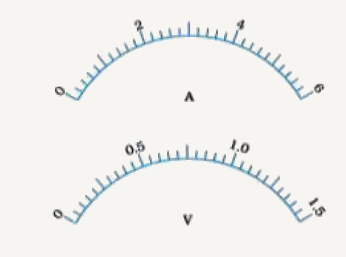A potential difference of 10 V is needed to make a current of 0.02 A flow through a wire. What potential difference is needed to make a current of 250 mA to flow through the same wire?Solution in Gujrati
According to the Ohm.s law,
R=VI
So, R=100.02
=500Ω
Now, to make a current of
250 mA = 250×10−3A to flow through the same wire, the required potential difference is
V=IR=250×10−3×500=125V
Topper's Solved these Questions
- ELECTRICITYBOOK - KUMAR PRAKASHANCHAPTER - ELECTRICITYEXERCISE - VALUE BASED QUESTIN WITH ANSWERS
15 Videos
- ELECTRICITYBOOK - KUMAR PRAKASHANCHAPTER - ELECTRICITYEXERCISE - PRACTICAL SKILL BASED QUESTION WITH ANSWERS
20 Videos
- ELECTRICITYBOOK - KUMAR PRAKASHANCHAPTER - ELECTRICITYEXERCISE - OBJECTIVE QUESTIONS AND ANSWERS (Choose the correct option from those given below each question: )
55 Videos
- MAGNETIC EFFECTS OF ELECTRIC CURRENT BOOK - KUMAR PRAKASHANCHAPTER - MAGNETIC EFFECTS OF ELECTRIC CURRENT EXERCISE - VALUE BASED QUESTIONS WITH ANSWERS
15 Videos
Similar Questions
Medha observed that the tubelights in the corridor of her school were always switched on the whole day. She brought the matter to the notice of her class teacher who talked to the Principal about it. The Principal took immediate action.
Medha helped this way to reduce air pollution. Explain how.
View SolutionThe scales of an ammeter and a voltmeter are shown below:

What is the range of the ammeter and the range of the voltmeter?
View SolutionThe SI unit of electric charge is the ……………… .
View SolutionShalini and his brother Amey observed a water-pump working , Shalini inquired how an electric motor works . Amey collected different parts of an electric motor e.g., field - magnets , cabon- brushes , armature , battery , switch, connecting wire , split - rings , etc, and showed them to Shalini . Amey then explained how an armature could rotate.
State the principle how an electric motor to works .
View SolutionA current of (2.5+-0.05) A flows through a wire and develops a potential difference of (10+-0.1) volt. Resistance of th wire in ohm, is
View SolutionA current of (2.5+-0.05) A flows through a wire and develops a potential difference of (10+-0.1) volt. Resistance of the wire in ohm, is
View SolutionAssertion : If a current flows through a wire of non-uniform cross-section, potential difference per unit length of wire is same throughout the length of wire. Reason : Current through the wire is same at all cross-sections.
View SolutionA p.d. of 10V is needed to make a current of 0.02A flow through a wire. What p.d. is needed to make a current of 250mA flow through the same wire?
View SolutionStatement I: IF a current flows through a wire of non-uniform cross section, potential difference per unit length of the wire in the direction of current is same at different points. Statement II:V=IR and the current in the wire is same throughout.
View SolutionA current of (2.5 +- 0.05) A flows through a wire and develops a potential difference of,(10 +- 0.076) volt.Resistance of the wire in ohm,is
View SolutionA current of (2.5+-0.05) A flows through a wire and develops a potential difference of (10+-0.076) volt.Resistance of the wire in ohm is
View Solutionఒక తీగ రెండు చివరల మధ్య పొటెన్షియల్ ఖేదం V, ఆ తీగలో ప్రవహించే విద్యుత్ I లకు సంబంధించిన గ్రాఫ్ గీయంటి. అ గ్రాఫ్ ఆకారం ఎలా ఉంది?
View SolutionWhen a current of (5±0.5) A flows through a wire, it developes a potential difference of (40±1)V. The resistance of wire is
View SolutionWhen a current of (5 +- 0.5)A flows through a wire, it develops a potential difference of (40 +- 1)V . The resistance of the wire is ......
View SolutionAssertion : If a current flows through a wire of non-uniform cross-section, potential difference per unit length of wire is same throughout the length of wire.
Reason : Current through the wire is same at all cross-sections.
View Solution
